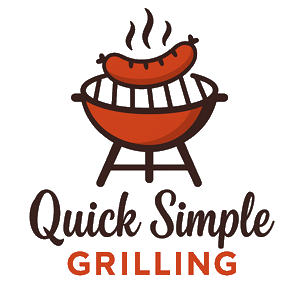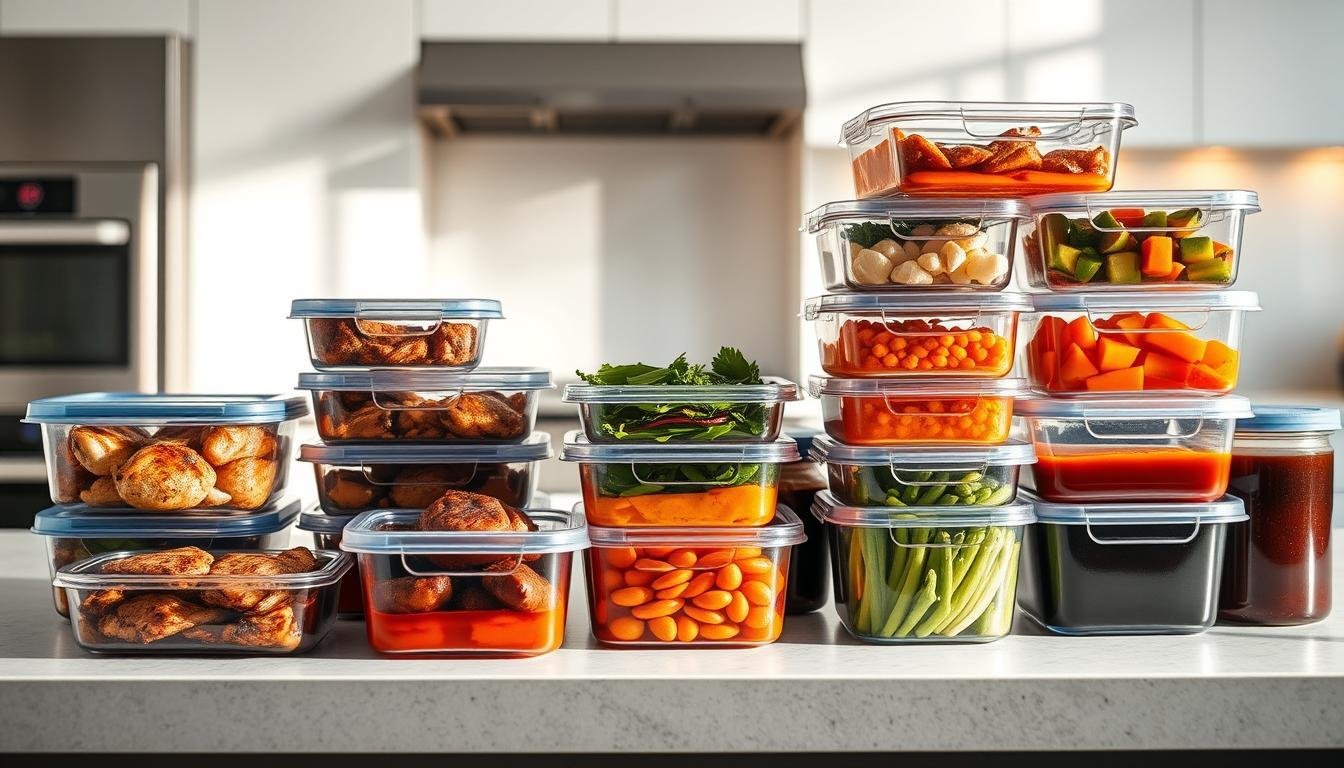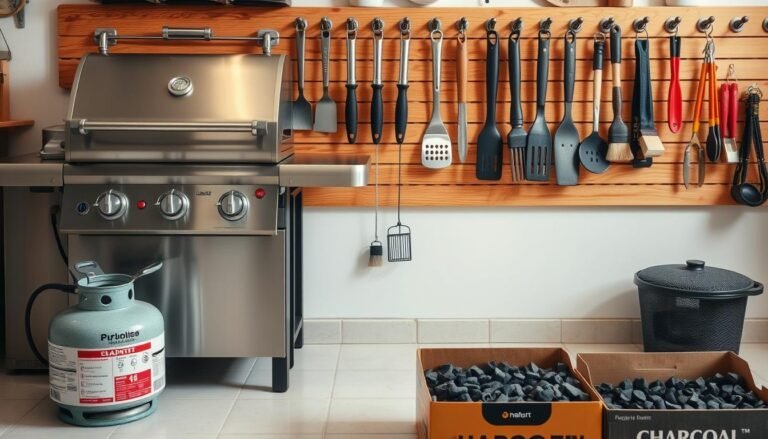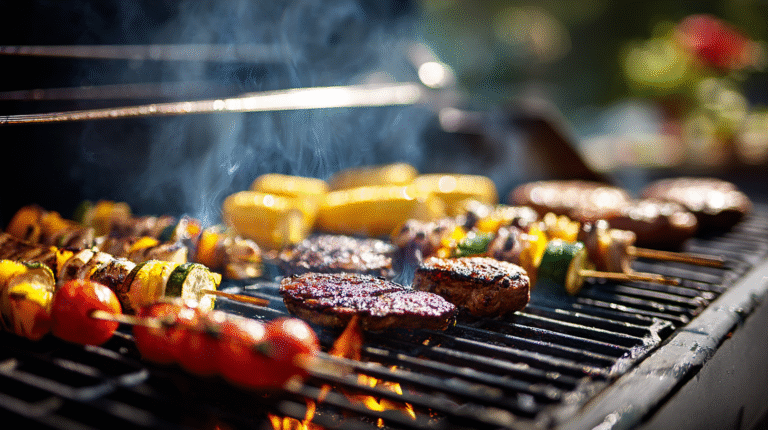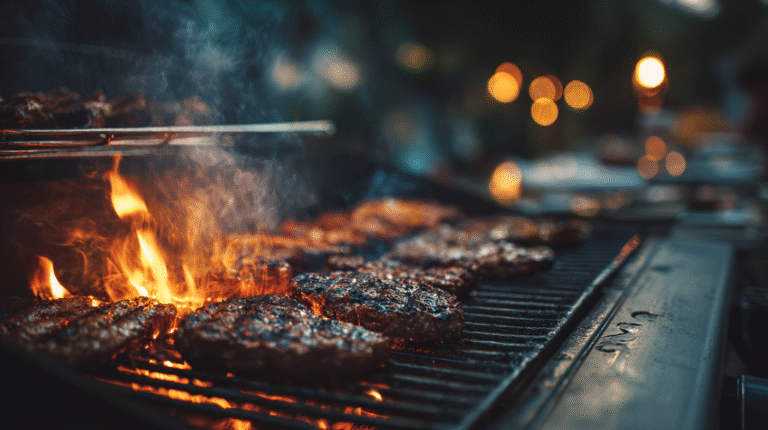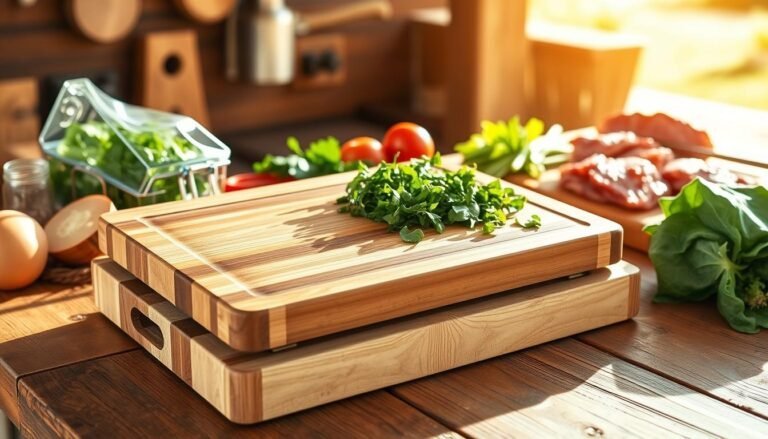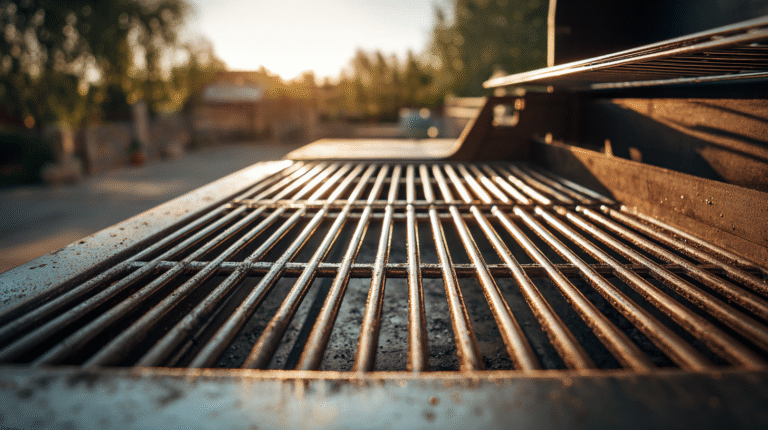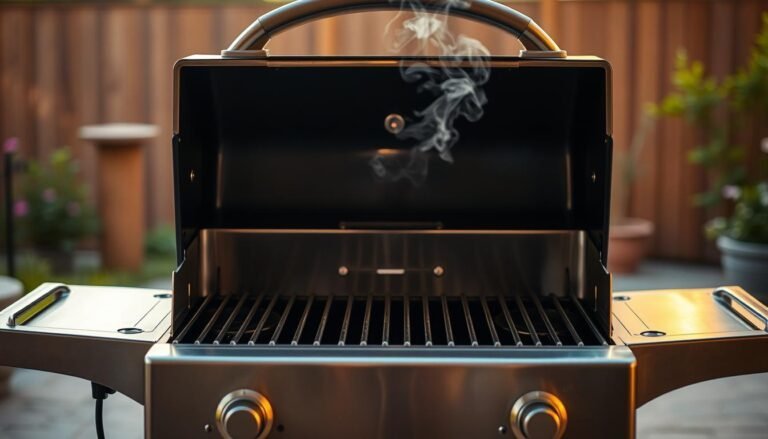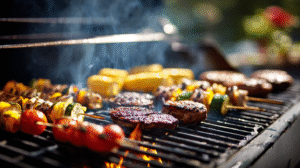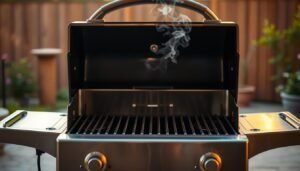Disclosure: This Post Contains Affiliate Links; We earn a commission on purchases.
Learning how to store barbecue leftovers is key to maximising enjoyment while minimising waste. By following food safety guidelines and using smart storage, your leftovers stay safe, tasty, and ready to eat anytime.
It’s important to handle leftover grilled food right to keep it good and safe. This means cooling it down fast, storing it in airtight containers, and heating it up to the right temperature. For more tips, check out our ultimate guide to storing barbecue. It has lots of advice on keeping food fresh.
Key Takeaways
- Cool leftovers promptly to prevent bacterial growth.
- Use airtight containers or resealable plastic bags for storage.
- Refrigerate or freeze leftovers within 2 hours of cooking.
- Reheat leftovers to 165°F (74°C) for food safety.
- Practice portion control to reduce waste and aid in faster cooling.
The Importance of Proper Leftover Management
Managing leftovers well is key to keeping food safe and cutting down on waste. Knowing how to store leftovers and keep grilled food safe is very important. It helps a lot in saving BBQ leftovers.
Food Safety Fundamentals
Keeping leftovers safe is very important. The “2-hour rule” is a basic rule. It says that perishable foods should not stay at room temperature for more than 2 hours.
Bacteria grow fast between 40°F and 140°F. So, it’s important to put leftovers in the fridge or freezer quickly. This simple step can greatly lower the chance of getting sick from food.
Economic and Environmental Benefits
Good leftover management is not just about safety. It also saves money and helps the environment. By storing leftovers right, families can cut down on waste. This is both cheaper and better for the planet.
For example, saving BBQ leftovers can save money. It also reduces the harm to the environment from making and throwing away food.
Food Safety Considerations for Grilled Leftovers
Enjoying leftover grilled food is easy if you follow food safety rules. Leftovers can be tasty and convenient. But, they need careful handling to avoid food poisoning.
Temperature control is key. Bacteria grow fast in temperatures between 40°F and 140°F. Keep perishable foods out of this range for less than two hours.
The Danger Zone: Temperature Control
Knowing the danger zone is important for safe food storage. Bacteria like Staphylococcus aureus and Clostridium perfringens can cause food poisoning. Refrigerate or freeze leftovers quickly to stop this.
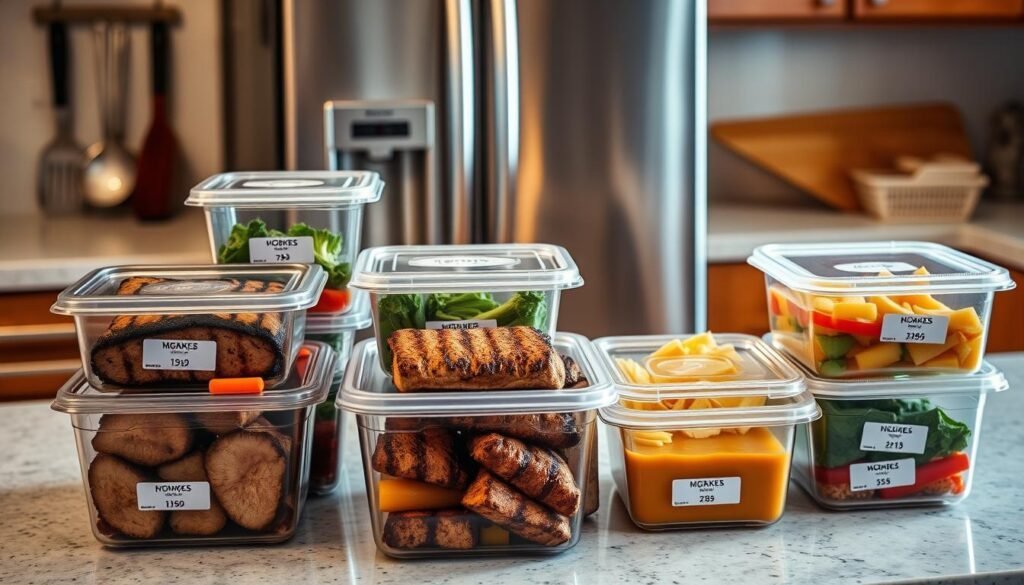
Time Limitations for Safe Storage
Grilled leftovers should be refrigerated at 40°F or below within two hours. Cooked food can last three to four days in the fridge. Freeze them if you won’t eat them in time.
Signs of Spoilage in Grilled Foods
Check for spoilage before eating leftover grilled food. Look for mold, slimy texture, or bad smell. If you see these, throw it away. Safe reheating practices are also key; reheat to 165°F to ensure safety.
By following these tips, you can safely enjoy your grilled leftovers. Proper food safety is key to keeping your food safe and tasty.
Comprehensive Guide to Leftover Grilled Food Storage and Reheating
To enjoy your grilled leftovers fully, knowing how to store and reheat them is key. Proper storage and reheating keep food safe and tasty. It also helps keep the food’s flavor and texture.
Cooling Techniques Before Storage
Cooling leftovers quickly is very important. Moving food to shallow containers helps it cool faster. This step is key to keeping your grilled leftovers safe and tasty.
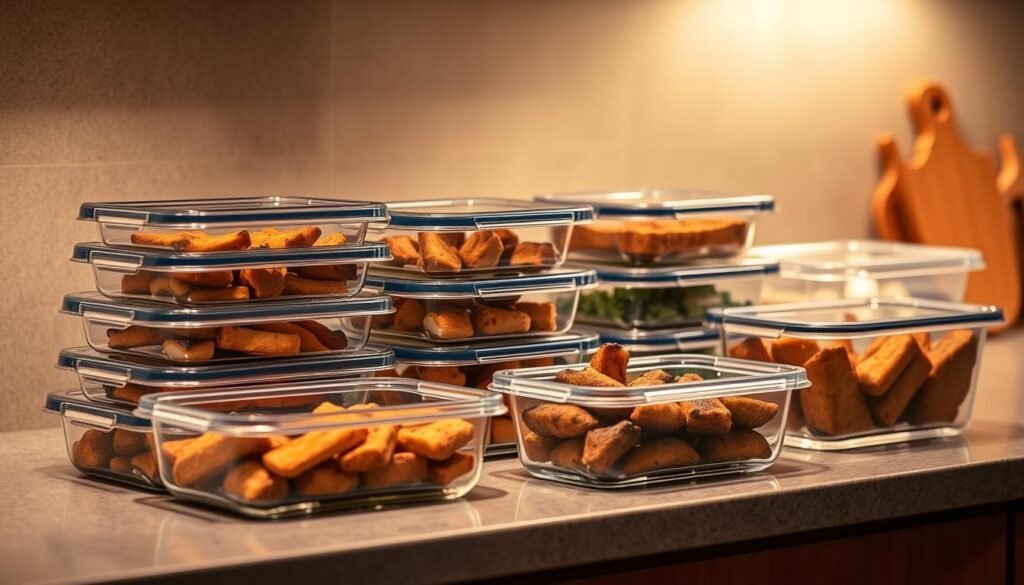
Proper Wrapping and Containment Methods
After cooling, leftovers need to be wrapped or contained right. This stops contamination and keeps moisture in. Using airtight containers or wrapping food in plastic or foil works well. It keeps food fresh and stops germs from spreading.
Refrigeration vs. Freezing Options
Choosing between refrigeration or freezing depends on when you’ll eat the leftovers. Refrigeration is good for a few days. Freezing is better for longer storage, lasting months. Always label frozen containers with date and contents.
By following these tips, you can enjoy your grilled leftovers safely and well. Whether you refrigerate or freeze, start with proper handling.
Storage Techniques for Different Types of Grilled Foods
Grilled foods need special storage to keep their taste and texture. This includes meats, seafood, veggies, and sauces. Knowing how to store each one is key to keeping them fresh and safe.
Beef, Pork, and Poultry
Grilled meats like beef, pork, and poultry must cool fast to stop bacteria. Use shallow containers to cool them quicker. Store them in the fridge at 40°F (4°C) or below within two hours.
For longer storage, freeze them. Wrap them tightly in airtight packaging or freezer bags to avoid freezer burn.
Tip: Mark containers or bags with the date and what’s inside. This helps you use the oldest first.
Seafood Considerations
Seafood is very perishable and needs careful handling. Store grilled seafood in a covered container in the fridge at 40°F (4°C) or below. Eat it within a day or two to avoid drying out.
Freezing is an option for longer storage. Freeze it as soon as you can after cooking. Use airtight packaging to keep its quality.
Vegetables and Plant-Based Options
Grilled veggies can last a few days in the fridge. Keep them in a sealed container or plastic bag to stay fresh. For tofu or tempeh, similar storage works, but they dry out faster. Wrap them tightly to keep them moist.
Sauces, Marinades, and Condiments
Sauces, marinades, and condiments need special storage based on their ingredients. Most can be refrigerated, but check the label. Some need refrigeration after opening, while others can stay at room temperature.
By using these storage tips for different grilled foods, you can enjoy leftovers safely and keep them fresh.
Expert Reheating Methods for Maximum Flavor and Safety
Reheating grilled leftovers is more than just warming them up. It’s about keeping their flavor and texture. Using the right reheating methods is key for food safety and quality.
Oven Reheating Techniques
Reheating in the oven helps keep food moist and flavorful. First, preheat your oven to 275°F (135°C). Then, put the leftovers in a covered dish to prevent drying. Heat until the food reaches 165°F. This works well for big cuts of meat.
Stovetop and Skillet Methods
For quick reheating, the stovetop or skillet is best. Use a small amount of oil or the food’s juices to keep it moist. Heat over medium-low, stirring often, until it’s 165°F inside.
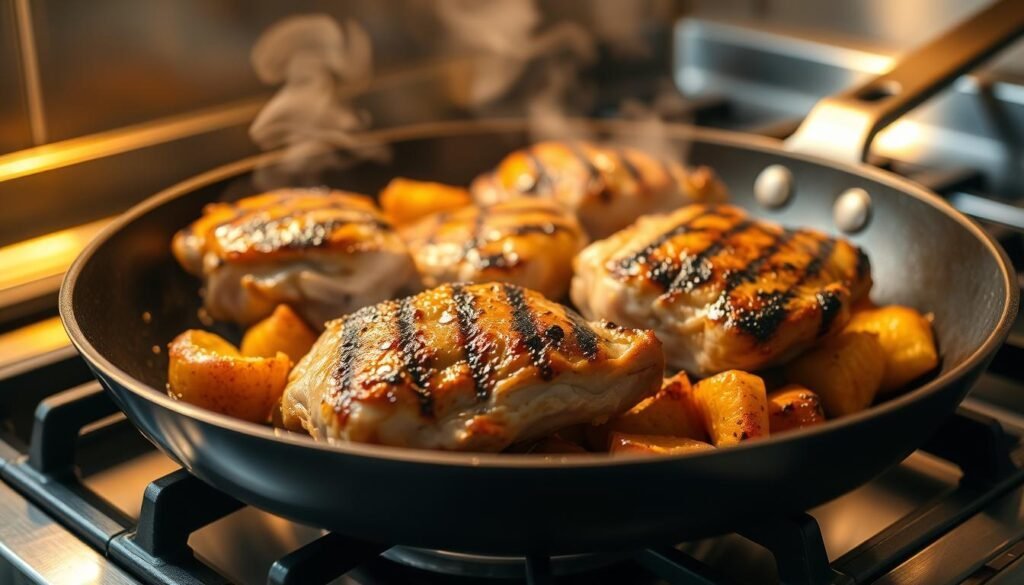
Microwave Reheating: Do’s and Don’ts
Microwaving is fast, but be careful to avoid hot spots. Cover the food to keep it moist and even. Heat in short bursts, checking the temperature until it’s 165°F. Let it stand for a minute before serving.
Grill Reheating for Authentic Flavor
Reheating on the grill brings back the real grilled taste. Preheat the grill to medium and place the leftovers on it. Reheat until it’s 165°F, turning often. This is great for burgers or veggies.
Always make sure your grilled leftovers are 165°F to avoid food poisoning. By using these expert methods, you can enjoy your food safely and with great flavor.
- Reheat to an internal temperature of 165°F for food safety.
- Choose the right reheating method based on the type and quantity of food.
- Use a food thermometer to ensure the correct internal temperature.
Putting it All Together: Enjoying Safe and Delicious Grilled Leftovers
Storing and reheating leftover grilled food right is key. It helps you enjoy tasty meals and cut down on waste. By following this Guide, your grilled leftovers will stay safe and delicious.
Managing leftover grilled food well means controlling temperature and using the right wrapping. Knowing when food has gone bad is also important. These tips help you enjoy your leftovers safely and with great taste.
Reheating beef, poultry, seafood, or veggies is easy with these methods. Next time you grill, don’t throw away leftovers. Use the tips from this Guide to store and reheat them safely and well.
FAQ
How long can I safely store leftover grilled food in the refrigerator?
What is the “danger zone” for bacterial growth in leftover grilled food?
Can I reheat leftover grilled food in the microwave?
How do I prevent grilled vegetables from becoming soggy during storage?
Can I freeze leftover grilled meat?
What are the signs of spoilage in leftover grilled food?
How do I reheat leftover grilled seafood safely?
Can I store leftover grilled sauces and marinades?

From quick grilling techniques to simple gear advice, Ryan helps beginners and busy home cooks fire up great meals without over-complicating it. Whether you’re using charcoal, gas, or a portable grill, Ryan’s goal is to make grilling approachable, fun, and full of flavor.
Subscribe to Our Newsletter
